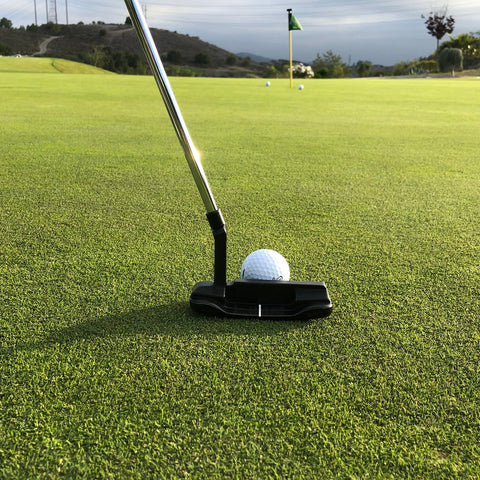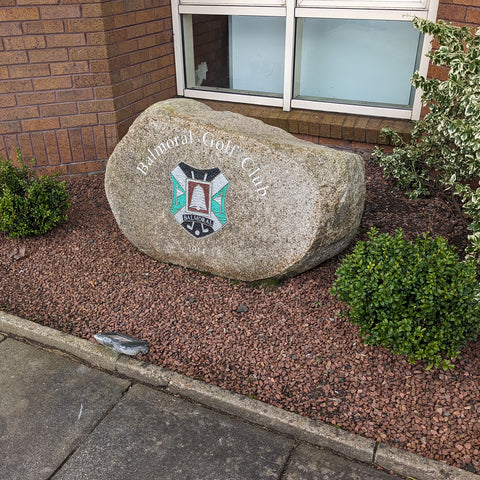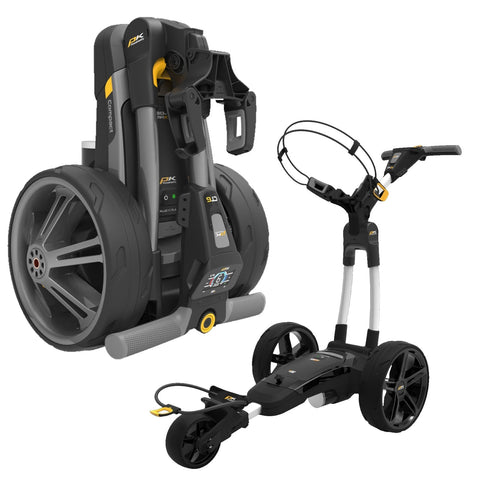In the world of golf, one club stands out as both simple and essential—the putter. Whether you're a seasoned golfer or just starting out, the putter is a club you can't do without. It's the instrument of precision on the green, the tool that can make or break your golf round with a single stroke.
This article aims to shed light on this critical piece of golf equipment. We'll explore what a putter is, why it's indispensable in a golfer's bag, and what you can expect to learn in the following sections.
Table of Contents
Section 1: Understanding the Putter
What Is A Putter?
The putter in golf is a club used to perform precise and controlled short-distance shots on the putting green, giving the player great control over path, distance and power to provide maximum control and accuracy. At its core, a putter is a golf club designed explicitly for putting. Unlike other clubs in a golfer's arsenal, such as drivers or irons, the putter's primary purpose is to roll the ball along the green and into the hole. It's the last club you use in any golf hole, making it the deciding factor between a par and a birdie, or a bogey and a double bogey.
The Putter's Role in the Game
The putter is often described as the "scoring club" because it is used for the shortest and most critical shots on the golf course—the ones that happen on the putting green. While other clubs are used for long-distance shots, the putter is all about finesse and precision, helping golfers achieve accurate and controlled rolls.
A Brief History and Evolution
To truly appreciate the putter's significance, it's essential to understand its history and evolution. Over the years, putters have undergone significant changes in design and materials, reflecting advancements in golf technology and a deep understanding of putting mechanics. We'll take a closer look at how putters have evolved to become the essential tool they are today.
Section 2: Anatomy of a Putter
What Are The Main Parts of a Putter?
The anatomy of a putter consists of three primary components: the head, shaft, and grip.
-
Head
The head of a putter is the most critical part. It comes in various shapes and sizes, and the design can significantly affect your putting performance. Some putter heads are blade-shaped, while others are mallet-shaped. Each design offers distinct advantages.
-
Shaft
The shaft is the long, slender part of the putter that connects the head to the grip. Shafts vary in length, and the choice of shaft length can influence the overall feel and control of your putting stroke.
-
Grip
The grip is where you hold the putter. It comes in different shapes and materials, allowing golfers to choose a grip that feels comfortable and promotes a consistent putting grip.
Design Elements and Significance
Design elements in putters play a crucial role in how the club performs on the green. For example, the alignment aids on the putter head help golfers line up their putts accurately. The materials used in the construction of the putter, such as stainless steel or carbon, can affect the feel and feedback you get during your stroke.
Blade vs. Mallet Putters
Blade and mallet putters are the two most common designs you'll encounter. Blade putters are characterized by a more streamlined, traditional look, and they are often favoured by golfers who prefer a classic feel. Mallet putters, on the other hand, have a larger and more forgiving head shape, making them popular among golfers seeking enhanced stability and alignment assistance.


Section 3: Putter Selection
Choosing the Right Putter
Selecting the right putter is a critical decision for any golfer looking to improve their game. Here are some guidelines to help you make an informed choice:
-
Putter Length
The length of the putter should match your posture and putting stance. A putter that's too long or too short can affect your putting accuracy.
-
Putter Weight and Balance
The weight of the putter head can influence the tempo of your stroke. Find a weight that complements your natural putting rhythm. Additionally, consider the balance of the putter, whether it's face-balanced or toe-balanced, to match your putting style.
-
Face Inserts and Alignment Aids
Some putters feature face inserts designed to enhance feel and provide a soft touch. Alignment aids, such as lines or dots on the putter head, can assist in aligning your putts more accurately. Choose features that align with your preferences and putting needs.
Selecting the right putter is a personal choice that takes into account your putting stroke, preferences, and the specific challenges you face on the greens. By considering factors like length, weight, balance, and design elements, you can improve your putting performance and ultimately lower your golf scores.
Section 4: Putter Techniques
Putting Stroke Paths: Arc vs. Straight
One of the key aspects of mastering putting is understanding and employing the correct putting stroke path. There are two primary putting stroke paths: the arc and the straight back and straight through (SBST) stroke.
-
Arc Putting Stroke
This is the most common type of putting stroke. In an arc stroke, the putterhead moves slightly inside the target line during the backswing, then follows an arc as it returns to the ball. This stroke often requires more precise timing but allows for better control over the face angle at impact.
-
Straight Back and Straight Through (SBST) Stroke
In an SBST stroke, the putterhead moves straight back and straight through along the target line. This stroke path is often considered more mechanically simple and can be easier to repeat consistently. Golfers who struggle with inconsistency in their putting often find success with this technique.
Face Balance vs. Toe Balance
Putter balance refers to how the putterhead behaves during the stroke. Understanding this concept is crucial for selecting the right putter for your game.
-
Face-Balanced Putters
Face-balanced putters are designed to stay square to the target throughout the stroke. These putters are well-suited for golfers with a straight-back, straight-through putting stroke (SBST). They tend to work best for players who don't have much face rotation during their strokes.
-
Toe-Balanced Putters
Toe-balanced putters are designed to open or close slightly during the stroke. They are often favored by golfers who have an arcing putting stroke. These putters can help golfers who need some assistance with squaring the face at impact.
Putting Grip Techniques
The way you grip the putter can significantly impact your putting performance. There are various putting grip techniques to consider:
-
Traditional Grip
Similar to a standard golf grip, the traditional grip involves both hands on the handle, with either an overlapping or interlocking finger configuration. It's a versatile grip suitable for various stroke types.
-
Cross-Handed (Left Hand Low) Grip
In this grip, the lead hand (left for right-handed golfers) is positioned lower on the handle than the trail hand. This grip can help reduce wrist movement and promote a smoother putting stroke.
-
Claw Grip
The claw grip involves a unique hand position, with the lead hand in a claw-like configuration. This grip can reduce wrist movement and provide stability.
-
Split Grip
: The split grip involves a separation between the hands on the handle, promoting a pendulum-like motion. It's known for its simplicity and consistency.
Experimenting with different grip techniques and understanding how they complement your stroke can lead to improved putting accuracy and consistency.
Section 5: Unconventional Putting Situations
Conceding Putts
In friendly games of golf, players often concede short putts to one another, meaning they agree that a particular putt is short enough that it's highly unlikely to be missed. This is a matter of courtesy and expedites play. However, in formal competitions, conceding putts may not be allowed.
Legality of Putting with No Backswing
In golf, the rules generally require that a player makes a "stroke" at the ball, which involves some form of backswing. However, there are situations where golfers might use a "chip" or "bunt" with their putter, essentially hitting the ball without a full backswing. While this technique is legal, it may not be suitable for all situations and is typically used when the player is very close to the hole and wants to ensure a delicate touch.
Understanding these unconventional putting situations and the associated rules can be valuable knowledge for golfers looking to navigate various scenarios on the course effectively.
Section 6: Etiquette and Rules
Etiquette Rules Related to Putting
In the gentleman's game of golf, etiquette is of utmost importance, and this extends to putting on the green. Here are some essential etiquette rules to keep in mind:
-
Respect Silence
When you're on the green or when others are putting, maintain silence. Unnecessary noise and movement can disrupt a player's concentration.
-
Fix Ball Marks
Always repair ball marks or pitch marks on the green, whether they're yours or not. It's a fundamental aspect of golf course etiquette that helps maintain the green's condition.
-
Line of Sight
Be mindful of your shadow and positioning on the green. Avoid standing in a way that could obstruct a fellow golfer's line of sight or casting a shadow over their putting line.
-
Pace of Play
Keep the pace of play moving smoothly. While you should take your time to read your putts, don't unnecessarily delay the game. If you're searching for a lost ball or need to spend extra time, allow faster groups to play through.

To successfully putt, cut strokes off your game and improve your handicap, practice as well as equipment that suits your style are essential.
Scenarios Involving a Moving Ball and Touching the Green
In certain situations, rules regarding a moving ball and touching the green come into play:
-
Moving Ball
If your ball is in motion and accidentally deflected or stopped by you, your caddie, or your equipment, there are specific rules to follow. Depending on the circumstances, you may need to replace the ball or incur a penalty. -
Touching the Green
Avoid touching the green with your putter or any other object. While you may mark and lift your ball for cleaning or to get out of the way of another player, take care not to damage the putting surface.
Standing Behind Opponents While They Putt
Etiquette dictates that you should avoid standing directly behind an opponent while they putt. This practice can be distracting and may interfere with their concentration. Instead, position yourself to the side or out of their line of sight to show respect for their putt.
Conclusion
A putter is not just another club in a golfer's bag—it's the key to success on the greens. We've explored the essential aspects of putters in golf, from their anatomy and selection to techniques and etiquette rules. Here are some key takeaways:
- Understanding your putting stroke path and selecting the right putter design can significantly improve your performance on the green.
- Putter length, weight, balance, and grip should be chosen with careful consideration of your individual preferences and putting style.
- Unconventional situations may require creative solutions, such as using a putter off the tee or understanding the rules of conceding putts.
- Golf etiquette is integral to the game, and respecting silence, fixing ball marks, and avoiding distractions on the green is part of being a courteous golfer.
FAQ
What is the primary purpose of a putter in golf?
The primary purpose of a putter in golf is to roll the ball along the green and into the hole. It is the club of precision on the putting green, designed for accurate and controlled short-distance shots.
How do I choose the right putter for my game?
When selecting a putter, consider factors like length, weight, and balance to match your putting stroke and preferences. Experiment with different putters to find the one that feels most comfortable and effective for you.
What are the two primary putting stroke paths, and which one should I use?
The two primary putting stroke paths are the arc and the straight back and straight through (SBST) stroke. The choice between them depends on your natural putting stroke. Experiment with both to determine which suits you best.
What's the difference between blade and mallet putters?
Blade putters have a more streamlined, traditional design, while mallet putters have a larger, more forgiving head shape. Blade putters are often favored by those who prefer a classic feel, while mallets provide stability and alignment assistance.
Can I use a putter for tee shots or other unconventional situations?
Yes, in certain situations, using a putter for tee shots or other unconventional scenarios can be strategic. For example, on short par-3 holes or when dealing with tricky lies, a putter can provide control and accuracy.
What are the etiquette rules related to putting in golf?
Etiquette rules include maintaining silence on the green, fixing ball marks, being mindful of your shadow, and respecting the pace of play. Additionally, avoid standing directly behind opponents while they putt to avoid distractions.
Are there rules regarding a moving ball or touching the green with a putter?
Yes, specific rules apply to situations involving a moving ball and touching the green with a putter. Understanding these rules is essential to avoid penalties and maintain good sportsmanship on the course.
 Free UK Delivery On Orders Over £25
Free UK Delivery On Orders Over £25
 90 Day Returns
90 Day Returns



